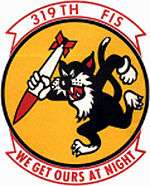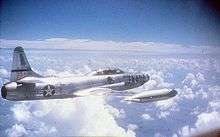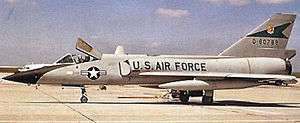319th Fighter Interceptor Training Squadron
| 319th Fighter Interceptor Training Squadron | |
|---|---|
|
319th Fighter-Interceptor Squadron F-106 58-0788 at Malmstrom AFB in[1] | |
| Active | 1942–1945; 1947-1969; 1971-1972; 1975-1977 |
| Country |
|
| Branch |
|
| Role | Fighter Interceptor Training |
| Motto | We Get Ours at Night |
| Engagements |
|
| Decorations |
|
| Insignia | |
| Emblem of the 319th Fighter Interceptor Squadron emblem (approved 28 May 1957)[2] |
 |
The 319th Fighter Interceptor Training Squadron is an inactive United States Air Force unit. Its last assignment was with Aerospace Defense Command's Interceptor Weapons School at Tyndall Air Force Base, Florida, where it was inactivated on 30 November 1977.
History
World War II
It was established in mid-1942 as a fighter squadron, and trained under I Fighter Command primarily in the northeast with Republic P-47 Thunderbolts. It was deployed to the Mediterranean Theater of Operations in Algeria, and took part in the North African Campaign supporting the United States Fifth Army's advance with tactical air support. It attacked enemy armored columns, troop concentrations, road transport, bridges and other targets of opportunity. It also flew combat missions over Sicily from airfields in Tunisia, supporting the Allied ground forces in the liberation of the island. The squadron was moved to Italy in late 1943 and continued tactical operations as part of Twelfth Air Force. It supported the Fifth Army as it advanced into central and northern Italy during the Italian Campaign. It was re-equipped with North American P-51D Mustangs in 1944. It continued combat operations until the German capitulation, and demobilized in northern Italy during the summer of 1945. It was inactivated in October.
Air Defense Operations
Panama and early West Coast

It was reactivated in 1947 at Rio Hato Air Base, Panama as part of the air defense forces of the Panama Canal. It was equipped with Northrop P-61 Black Widows at Shaw Air Force Base, South Carolina, then deployed to Panama in September. It later moved to France Field in the Canal Zone and became part of Caribbean Air Command. It was equipped from inactivating 414th and 415th Night Fighter Squadrons. Its war-weary Black Widows were retired in 1948 and replaced with very long range North American F-82 Twin Mustangs. However this type of air defense was deemed unnecessary in the Canal Zone and the squadron was returned to the United States and assigned to McChord Air Force Base, Washington in 1949, for air defense of the Pacific Northwest. It was moved to Moses Lake Air Force Base in September to provide air defense over the Hanford Reservation in Eastern Washington. It was re-equipped with the new Lockheed F-94 Starfire.
Korean War

As a result of the Korean War, in December 1951 Fifth Air Force determined a need for additional nighttime all-weather air interceptors in the Seoul area. In response, Air Defense Command provided the 319th FIS, which was reassigned from Moses Lake AFB, Washington, to Suwon Air Base, South Korea in February and early March 1952. Until November 1952, Fifth Air Force restricted the use of the Starfires to local air defense in order to prevent the possible compromise of its airborne intercept radar equipment in a loss over enemy-held territory. From November until the Armistice Agreement of 1953, the 319th used F-94s to maintain fighter screens between the Yalu and Chongchon Rivers in North Korea, helping to protect Boeing B-29 Superfortress bombers from enemy interceptors.
Return to the United States
The squadron returned to the United States in 1954 to Bunker Hill Air Force Base, Indiana and in March 1956 received F-94Cs. The squadron transitioned into F-89J Scorpions in the fall of 1957 and in February 1960 into Convair F-106 Delta Darts. On 22 October 1962, before President John F. Kennedy told Americans that missiles were in place in Cuba, the squadron dispersed one third of its force, equipped with nuclear tipped missiles to Hulman Field at the start of the Cuban Missile Crisis.[3][4] These planes returned to Bunker Hill after the crisis. However, ADC continued to maintain deployed fighters from other squadrons on alert in Florida.[5]

ADC decided to make its deployed fighter unit at Homestead Air Force Base permanent and equip it with Lockheed F-104A Starfighters because of the F-104's superior fighter on fighter performance.[6] ADC had released all its F-104s to the Air National Guard in 1960 because its fire control system was not sophisticated enough to make it an all weather interceptor.[7] However, the lack of all weather capability was not a factor in south Florida because Cuba lacked a bomber force. The Air Force withdrew F-104s from the 159th Fighter-Interceptor Squadron at McEntire Air National Guard Base to equip the Homestead squadron.[6]
In March 1963 the 319th was moved on paper to Homestead, and on 15 April, assumed an alert posture with F-104As.[8] These planes replaced a detachment of F-102s from the 325th Fighter-Interceptor Squadron that had been at Homestead since the Cuban missile crisis.[9] In addition, the squadron received the two-seat, dual-control, combat trainer F-104B. The performance of the F-104B was almost identical to that of the F-104A, but the lower internal fuel capacity reduced its effective range considerably. The F-104A was armed with AIM-9 Sidewinder missiles only. In 1964, to improve its capability against the expected threat, the 319th's F-104s began to be equipped with M-61 Vulcan cannons. During the period when the squadron's planes were being modified, the 479th Tactical Fighter Wing deployed F-104Cs, which were already armed with the M-61, to augment the alert force at Homestead.[10]
These ADC F-104As remained in service for several years. From late 1967, 26 aircraft of the 319th FIS were retrofitted with the more powerful J79-GE-19, rated at 17,900 lb. static thrust with afterburner, which was the same type of engine fitted to the F-104S version developed for Italy. The last active duty USAF squadron to operate the F-104A, the 319th was inactivated in December 1969.
In July 1971 the squadron was reactivated at Malmstrom Air Force Base, Montana, replacing the 71st FIS with F-106s. Shortly thereafter on 30 April 1972, the squadron was inactivated.
Training with the Air Defense Weapons Center
The unit designation was reactivated as 319th Fighter Interceptor Training Squadron at Tyndall Air Force Base, Florida in June 1975. More than two years later the unit was again inactivated on 1 November 1977.
Lineage
- Constituted as the 319th Fighter Squadron on 24 June 1942
- Activated on 3 August 1942
- Inactivated on 28 October 1945
- Activated on 1 September 1947
- Redesignated 319th Fighter Squadron (All Weather) on 17 June 1948
- Redesignated 319th Fighter-All Weather Squadron on 20 January 1950
- Redesignated 319th Fighter-Interceptor Squadron on 1 May 1951
- Inactivated on 1 December 1969
- Activated on 1 July 1971
- Inactivated on 30 April 1972
- Redesignated 319th Fighter Interceptor Training Squadron on 6 June 1975
- Activated on 30 June 1975
- Inactivated on 30 November 1977
Assignments
- 325th Fighter Group, 3 August 1942 – 28 October 1945
- 6th Fighter Wing, 1 September 1947
- Sixth Air Force (attached to Provisional Composite Group), 1 February 1948
- 6th Fighter Wing, 1 June 1948
- 5620th Group, 26 July 1948
- 5620th Composite Wing, 12 October 1948
- Fourth Air Force, 12 May 1949
- 325th Fighter (later Fighter-All Weather, 1 July 1949
- 4703d Defense Wing, 6 February 1952 (attached to Fifth Air Force after 1 March 1952)
- Western Air Defense Force, 7 April 1952 (attached to Fifth Air Force until 20 February 1954, 8th Fighter-Bomber Wing, until 17 August 1954, 35th Fighter-Interceptor Wing until 1 September 1954, then to Fifth Air Force)
- 4706th Air Defense Wing, 1 October 1955 (attached to Fifth Air Force until c. 18 October 1955)
- 58th Air Division, 1 March 1956
- 30th Air Division, 1 September 1958
- Detroit Air Defense Sector, 1 April 1959
- Chicago Air Defense Sector, 1 July 1960
- Montgomery Air Defense Sector, 1 March 1963 – 1 December 1969
- 21st Air Division, 1 July 1971 – 30 April 1972
- Air Defense Weapons Center, 1 June 1975 – 30 November 1977
Stations
|
|
Aircraft
|
|
See also
| Wikimedia Commons has media related to 319th Fighter-All Weather Squadron. |
References
Notes
- ↑ The plane carries the tail markings of the 71st FIS, from which it was transferred in July 1971 with the 319th FIS squadron emblem overlaid on top,
- ↑ Maurer, Maurer, ed. (1982) [1969]. Combat Squadrons of the Air Force, World War II (PDF) (reprint ed.). Washington, DC: Office of Air Force History. pp. 390–391. ISBN 0-405-12194-6. LCCN 70605402. OCLC 72556.
- ↑ McMullen, Richard F. (1964) "The Fighter Interceptor Force 1962-1964" ADC Historical Study No. 27, Air Defense Command, Ent Air Force Base, CO (Confidential, declassified 22 Mar 2000), pp. 10-12
- ↑ NORAD/CONAD Participation in the Cuban Missile Crisis, Historical Reference Paper No. 8, Directorate of Command History Continental Air Defense Command, Ent AFB, CO , 1 Feb 63 (Top Secret NOFORN declassified 9 March 1996). p. 16
- ↑ McMullen p. 12
- 1 2 McMullen, p. 17
- ↑ McMullen, p. 6
- ↑ McMullen, p. 18
- ↑ NORAD/CONAD Participation in the Cuban Missile Crisis, p. 32
- ↑ McMullen, p. 19
Bibliography
![]() This article incorporates public domain material from websites or documents of the Air Force Historical Research Agency.
This article incorporates public domain material from websites or documents of the Air Force Historical Research Agency.
- Cornett, Lloyd H.; Johnson, Mildred W. (1980). A Handbook of Aerospace Defense Organization, 1946–1980 (PDF). Peterson AFB, CO: Office of History, Aerospace Defense Center.
- Futrell, Robert F. (1983). The United States Air Forces in Korea 1950-1953. Washington, DC: Office of Air Force History. ISBN 0-912799-71-4.
- Maurer, Maurer, ed. (1982) [1969]. Combat Squadrons of the Air Force, World War II (PDF) (reprint ed.). Washington, DC: Office of Air Force History. ISBN 0-405-12194-6. LCCN 70605402. OCLC 72556.
- McMullen, Richard F. (1964) "The Fighter Interceptor Force 1962-1964" ADC Historical Study No. 27, Air Defense Command, Ent Air Force Base, CO (Confidential, declassified 22 Mar 2000)
- Pape, Garry R.; Campbell, John M.; Campbell, Donna (1991). Northrop P-61 Black Widow: The Complete History and Combat Record. Minneapolis, MN: Motorbooks International. ISBN 978-0-879385-09-5.
- NORAD/CONAD Participation in the Cuban Missile Crisis, Historical Reference Paper No. 8, Directorate of Command History Continental Air Defense Command, Ent AFB, CO, 1 Feb 63 (Top Secret NOFORN declassified 9 March 1996)
- "ADCOM's Fighter Interceptor Squadrons". The Interceptor (January 1979) Aerospace Defense Command, (Volume 21, Number 1)
External links
| ||||||||||||||||||||||||||||||||||||||||||||||||||||||||||||||||||||||||

